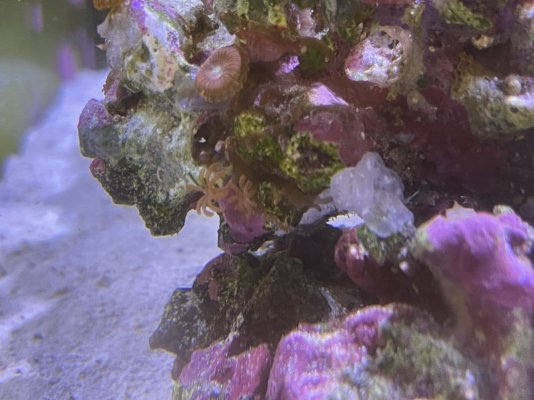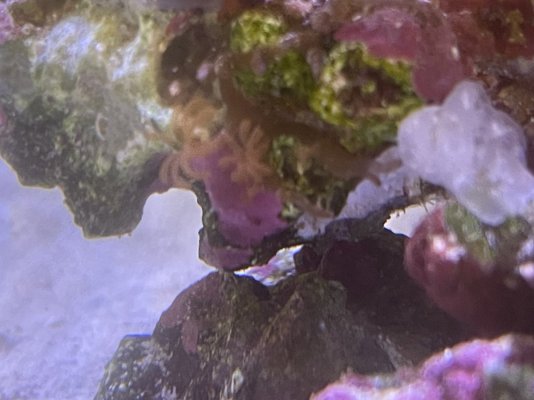Navigation
Install the app
How to install the app on iOS
Follow along with the video below to see how to install our site as a web app on your home screen.
Note: This feature may not be available in some browsers.
More options
You are using an out of date browser. It may not display this or other websites correctly.
You should upgrade or use an alternative browser.
You should upgrade or use an alternative browser.
What are these?
- Thread starter FishKeeper.mp3
- Start date
- Tagged users None
An invasive octocoral (like clove polyps and their relatives) of some kind - there have been enough of these popping up recently that I'm tempted to try and actually figure out how to differentiate the various kinds.
Regardless, they're highly invasive, and it looks like they're going to be spreading more in your tank soon - the little, gelatinous mat you can see them growing from is going to spread and sprout more polyps, and the polyps can drop pieces that grow into new, mat-forming corals.
If you think you can remove the entire thing (mat and all) without losing pieces in the tank, you can try manual removal, but with at least some species (such as Blue Clove Polyps) the only really effective method I'm aware of is Fenbendazole.
Regardless, they're highly invasive, and it looks like they're going to be spreading more in your tank soon - the little, gelatinous mat you can see them growing from is going to spread and sprout more polyps, and the polyps can drop pieces that grow into new, mat-forming corals.
If you think you can remove the entire thing (mat and all) without losing pieces in the tank, you can try manual removal, but with at least some species (such as Blue Clove Polyps) the only really effective method I'm aware of is Fenbendazole.
Kalk paste?An invasive octocoral (like clove polyps and their relatives) of some kind - there have been enough of these popping up recently that I'm tempted to try and actually figure out how to differentiate the various kinds.
Regardless, they're highly invasive, and it looks like they're going to be spreading more in your tank soon - the little, gelatinous mat you can see them growing from is going to spread and sprout more polyps, and the polyps can drop pieces that grow into new, mat-forming corals.
If you think you can remove the entire thing (mat and all) without losing pieces in the tank, you can try manual removal, but with at least some species (such as Blue Clove Polyps) the only really effective method I'm aware of is Fenbendazole.
Kalk paste and other Aiptasia removal methods may be worth a shot (I don't know that they would work, but I've only really seen big clove polyps infestations where it wouldn't really be feasible, so it might), but you'd want to really keep an eye out for dropped or missed pieces.Kalk paste?
Ok, thank you for the id.An invasive octocoral (like clove polyps and their relatives) of some kind - there have been enough of these popping up recently that I'm tempted to try and actually figure out how to differentiate the various kinds.
Regardless, they're highly invasive, and it looks like they're going to be spreading more in your tank soon - the little, gelatinous mat you can see them growing from is going to spread and sprout more polyps, and the polyps can drop pieces that grow into new, mat-forming corals.
If you think you can remove the entire thing (mat and all) without losing pieces in the tank, you can try manual removal, but with at least some species (such as Blue Clove Polyps) the only really effective method I'm aware of is Fenbendazole.
Similar threads
- Replies
- 26
- Views
- 875
- Replies
- 5
- Views
- 144
- Replies
- 2
- Views
- 77















